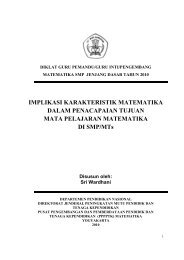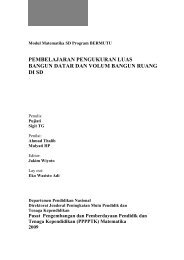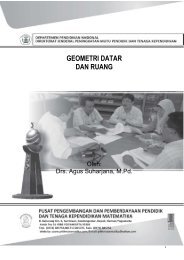25 Biggest Mistakes Teachers Make and How to Avoid Them
25 Biggest Mistakes Teachers Make and How to Avoid Them
25 Biggest Mistakes Teachers Make and How to Avoid Them
You also want an ePaper? Increase the reach of your titles
YUMPU automatically turns print PDFs into web optimized ePapers that Google loves.
Introduction<br />
mistakes. Conceivably, teachers can learn valuable lessons from their mistakes,<br />
but if those mistakes are potentially damaging <strong>to</strong> a student either<br />
physically or psychologically, then those lessons are <strong>to</strong>o costly in terms of<br />
human capital <strong>to</strong> learn by doing. Canfield (1990) reminds us that we must<br />
create classrooms that are physically <strong>and</strong> psychologically safe for all students.<br />
Therefore, it behooves us <strong>to</strong> minimize the number <strong>and</strong> type of mistakes<br />
made in teaching. As a preventive measure, it seems plausible that the<br />
scenarios in this book could provide an important teaching <strong>to</strong>ol for teacher<br />
preparation classes. I think a book that addresses these mistakes will provide<br />
a useful <strong>to</strong>ol of prevention <strong>and</strong> intervention for preservice teachers, practicing<br />
teachers, <strong>and</strong> others concerned with effective teaching. There are many<br />
books on positive teaching, discipline, <strong>and</strong> management, but I have yet <strong>to</strong><br />
encounter a book that seeks <strong>to</strong> teach from the proposed “undesirable teaching”<br />
perspective offered by the scenarios.<br />
I am writing about mistakes, not because I have never made any, but<br />
because I have learned from them. I also believe that we can learn a lot from<br />
the mistakes of others. The <strong>to</strong>ne of this book is not <strong>to</strong> criticize teachers for<br />
making mistakes; instead, the purpose is <strong>to</strong> offer a way for teachers <strong>to</strong> learn<br />
lessons about teaching by learning from the mistakes of other teachers.<br />
B<strong>and</strong>ura (1986) would call this vicarious or observational learning. Using<br />
mistakes as a teaching strategy is much like simulation—<strong>to</strong> learn important<br />
lessons a teacher does not have <strong>to</strong> actually engage in a mistake <strong>to</strong> learn from<br />
it. I recall making my share of mistakes when I started teaching elementary<br />
school. I can remember one mistake in particular where my intentions were<br />
good, but my judgment was poor. I volunteered <strong>to</strong> teach a dance class after<br />
school for my fifth graders. We were invited <strong>to</strong> perform at a neighboring high<br />
school <strong>and</strong> everyone joined in the preparations. I designed their costumes.<br />
They wore imitation leopard-skin cloth over black leotards. I added a long,<br />
wispy, thin scarf of similar material for effect. The night of the performance,<br />
I thought it would be dramatic <strong>to</strong> have the girls hold c<strong>and</strong>les as they danced.<br />
It looked beautiful ...at first. When I saw some of those scarves come dangerously<br />
close <strong>to</strong> the flames my heart skipped a beat <strong>and</strong> almost s<strong>to</strong>pped.<br />
I suddenly realized that I had put my girls in danger. It was <strong>to</strong>o late <strong>to</strong> s<strong>to</strong>p<br />
the performance because it was almost over. I just prayed that nothing terrible<br />
would happen. Fortunately, my prayers were answered; my poor judgment<br />
did not result in physical injury <strong>to</strong> my students. I’ll always remember<br />
that my students could have been seriously injured <strong>and</strong> it would have been<br />
my fault. I am sure that some of the teachers in these scenarios have similar<br />
thoughts <strong>and</strong> regrets.<br />
This book is designed <strong>to</strong> present each reflective scenario as it was written.<br />
Each scenario is analyzed <strong>to</strong> identify the key issues <strong>and</strong> seminal problems.<br />
The Rx used in this book is an alteration of the symbol used in prescriptions;<br />
in this academic context, it means a solution for a disorder or problem<br />
(American Heritage Dictionary, 1992). This Rx symbol is used throughout the<br />
book <strong>to</strong> signal the analyses <strong>and</strong> solutions for the problems in the scenarios.<br />
3





